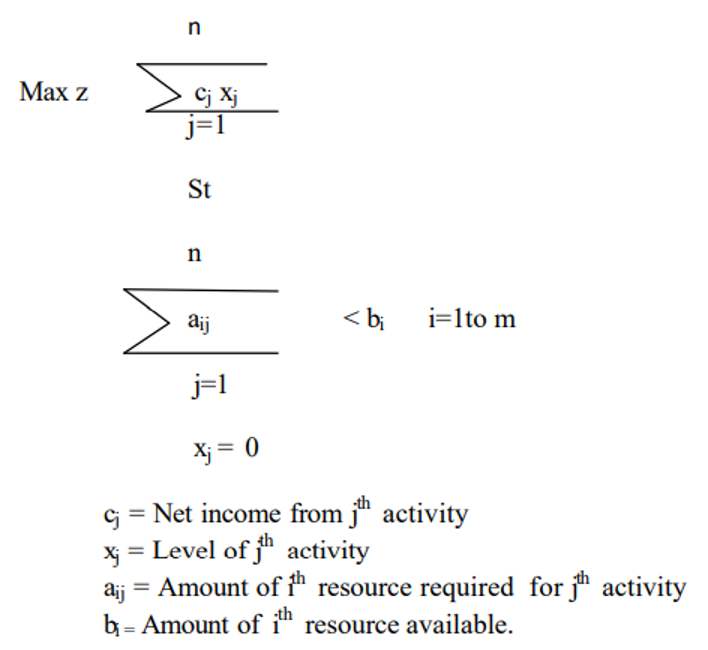🎰 Linear Programming
Learn about Linear Programming
- Linear programming was developed by
George B Dantzing(1947) during second world war. - It has been widely used to find the
optimum resource allocationandenterprise combination. - The word linear is used to describe the relationship among two or more variables which are directly proportional. For example, doubling (or tripling) the production of a product will exactly double (or triple) the profit and the required resources, then it is linear relationship.
- Programming implies planning of activities in a manner that achieves some optimal result with restricted resources.
Definition of L.P.
- Linear programming is defined as the optimization (Minimization or maximization) of a linear function subject to specific linear inequalities or equalities.
- LP is used in
optimization problemslike,- Minimization of Cost
- Minimization of use of resources
- Maximization of Profit

Assumptions of Linear Programming
- Linearity: It describes the relationship among two or more variables which are directly proportional.
- Additivity: Total input required is the sum of the resources used by each activity. Total product is sum of the production from each activity.
- Divisibility: Resources can be used in fractional amounts. Similarly, the output can be produced in fractions.
- Non negativity: Resources and activities
cannot take negative values. That means the level of activities or resources cannot be less than zero. - Finiteness of activities and resource restrictions: There is limit to the number of activities and resource constraints.
- Single value expectations: Resource supplies, input-output coefficients and prices are known with certainty.
Advantages of L.P.
- Allocation problems are solved.
- Provides possible and practical solution.
- Improves the quality of decisions.
- Highlights the constraints in the production.
- Helps in optimum use of resources.
- Provides information on marginal value products (shadow prices).
Limitations
- Linearity
- Considers only one objective for optimization.
- Does not consider the effect of time and uncertainty
- No guarantee of integer solutions
- Single valued expectations.


- Linear programming was developed by
George B Dantzing(1947) during second world war. - It has been widely used to find the
optimum resource allocationandenterprise combination. - The word linear is used to describe the relationship among two or more variables which are directly proportional. For example, doubling (or tripling) the production of a product will exactly double (or triple) the profit and the required resources, then it is linear relationship.
- Programming implies planning of activities in a manner that achieves some optimal result with restricted resources.
Definition of L.P.
- Linear programming is defined as the optimization (Minimization or maximization) of a linear function subject to specific linear inequalities or equalities.
- LP is used in
optimization problemslike, …
Become Successful With AgriDots
Learn the essential skills for getting a seat in the Exam with
🦄 You are a pro member!
Only use this page if purchasing a gift or enterprise account
Plan
Rs
- Unlimited access to PRO courses
- Quizzes with hand-picked meme prizes
- Invite to private Discord chat
- Free Sticker emailed
Lifetime
Rs
1,499
once
- All PRO-tier benefits
- Single payment, lifetime access
- 4,200 bonus xp points
- Next Level
T-shirt shipped worldwide

Yo! You just found a 20% discount using 👉 EASTEREGG

High-quality fitted cotton shirt produced by Next Level Apparel